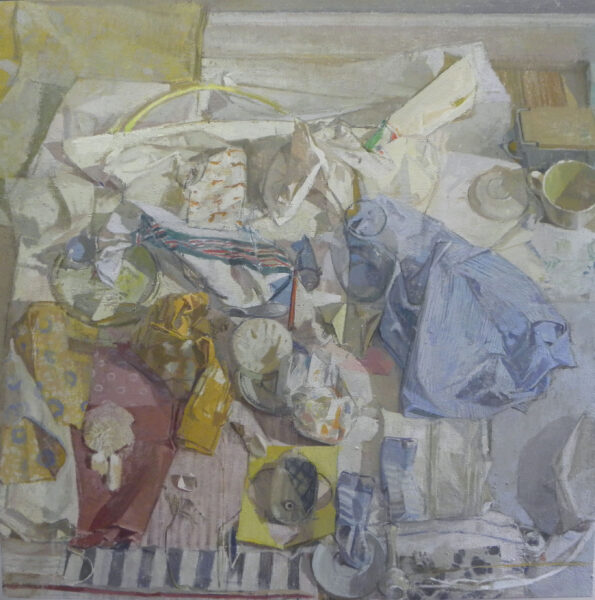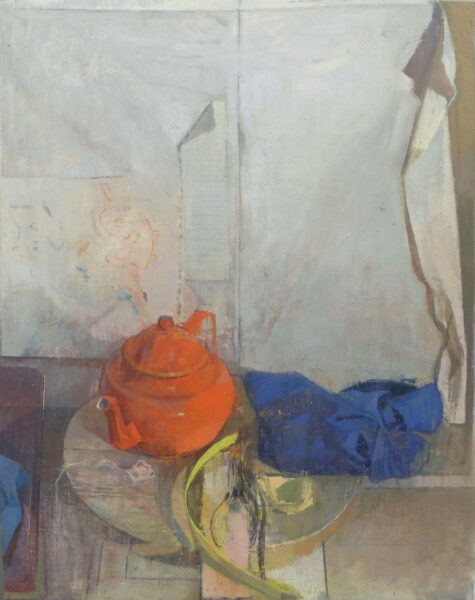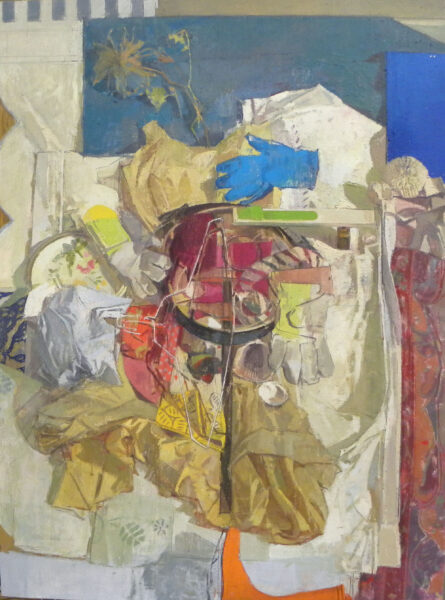
Edmond Praybe: PCA&D welcomes ‘In Depth’ exhibition, still life artist
Wednesday, April 5th, 2023
Edmond Praybe is drawn to still life painting because it combines two of his favorite aspects of painting: “responding to direct observation and fine-tuning formal abstraction.”
One of 30 artists in the Main Gallery’s upcoming exhibition, In Depth, Praybe will visit campus on Thursday, April 20 to deliver an Artist Talk at 12:45 pm and visit with Fine Art seniors. The Artist Talk, held in the College Atrium, is open to the public.
Praybe says he is “by no means a ‘natural painter’ — whatever that means. It took me a very long time to make anything that wasn’t terrible, in terms of both technique and construction.” He stuck with it, he says, because “there was something so incredibly engaging about the problem-solving process of developing a painting. You never really figure it out and, because of that, it is equal parts unbelievably frustrating and tremendously rewarding.
“There are endless ways to put a painting together and, as much as it seems like it has all been done before, it is also new each time you do it. And that creates new problems that require new inventive solutions.”
We asked Praybe about the challenges that draw him to still life painting, what lessons he carries over from his undergraduate days (hint: consistency plays a role), and what his daily life is like. Some answers have been lightly edited for length.

“Once Around the Sun,” Edmond Praybe
When you entered Maryland Institute College of Art, and when you continued at the New York Studio School, did you know painting would be your focus? What is it that speaks to you about this medium?
Edmond Praybe: When I entered MICA as an undergrad, I had no idea what I wanted to do! I knew that I wanted to make art professionally in some way, but I did not have a clear direction. I painted a bit in high school and I was always drawing from the time I was very young, but I didn’t know how that could translate into a career. I briefly considered graphic design and illustration, but after my first painting course at MICA, I just knew for sure that I wanted to be a painter. I credit my Painting I instructor, Carl Plansky, for that, as well as many other amazing instructors since, for making me want to stick with it. I had a six-year gap between undergrad and graduate school, during which time I continued to paint and work through issues I began exploring as an undergrad.
I love both the materiality of the paint itself along with all of the formal possibilities of the medium. That, in combination with the rich history of the medium, makes it a continuously fascinating art form in which to work. If you appreciate painting, you can go to a museum and potentially become engaged with a work from any period or culture and it can lead you to new ideas in your own work. Even more than that, it can give you a wider perspective on common threads as well as divergent attitudes towards specific ideas in painting (and by extension worldviews) across those various cultures or points in history.

“Orange Teapot,” Edmond Praybe
What is the challenge that draws you to still life painting? What do you look for when setting up what you’ll paint?
EP: I think of my still lifes as abstract paintings built out of objects. I love how I can change anything in the set-up as needed to respond to issues of color, value, form, composition, etc. I find still life painting very alive and dynamic because I never feel obligated by the objects in my set-ups. I can always change elements that are not working or make alterations in response to new concerns that arise during the painting process. This becomes much more difficult if I want to remain “true” to the observed world when I’m dealing with a figure or landscape, for example. With still life, I can create my own worlds and they only have to make sense in a purely visual way. Even if I begin with an idea or sense of narrative, I tend to follow what the painting needs rather than hold on too tightly to any initial concept.
When I set up a still life, I usually begin intuitively with a few key objects that I have an interest in painting. It may be the objects on their own or the relationships between a group of objects that get me started. From there, I begin to adjust variations in their placement, spacing, contrasting or similar values and colors, and add or take away other objects. I’m very aware of disrupting the ground plane (the table or floor) with various cloths and papers to ensure that the negative spaces have a presence in the painting that is as equally considered as the major objects themselves. The flow of clutter vs. open spaces is another key element I think about when setting up. Some still lifes skew more towards being very cluttered with a few breathing areas, while others are more open with a core spot or two of activity, tension, or pressure.
Do you feel like you’ve found “your voice,” or do you find yourself still experimenting?
EP: I’m always experimenting. I try not to think about my paintings having a certain “look” or “style” or consciously maintaining a voice consistent with past work. I follow whatever the main thrust of the painting seems to be about, as it reveals itself over time, and. I trust that it will fit into my overarching body of work in some way. I’ve tried in the past to make what I thought would be consistent bodies of paintings and they often felt stale, like I was trying to repeat myself. I usually end up painting over those pieces. Now I go wherever my interests take me: a color idea, compositional puzzles, value relationships, how to make a certain set of objects relate to one another, etc. As I make more and more explorations, a range of possibilities that feels like “my work” or “my voice” has started to emerge organically. That range continues to push outwards with each new painting: Some works are more “realist,” while others are more “abstracted,” some are very tonal and subtle, others are about intense color relationships, some are more painterly, while others have a more classical approach towards drawing.

“Gloves,” Edmond Praybe
What does your continued teaching bring to your work?
EP: It forces me to be very specific about what I feel is important about any given topic. Putting together classes and workshops challenges me to be direct and concise about issues in painting that are often very complex and nuanced. How do you distill the essentials of something like color relationships or composition in painting over a few lessons? I’m forced to be more decisive about what I really want to pass on to students, which in turn can help me better focus on those elements in my own work.
Revisiting some of my own assignments/projects after seeing what students do with them is extremely valuable for me as well. It can push my work in new directions if I feel I’m getting stuck or repetitive. It makes me more open to new possibilities in my own work when I see how someone else interprets shape relationships or close-value color transitions, for example.
Conversations during classes frequently make me appreciate things I didn’t notice in a painting/painter, give me new ideas about materials, and offer tips on good art books: monographs, criticism and theory and instructional. All these in turn have an impact on how I look at my own work in the studio.
What lessons do you still carry over from your undergraduate days?
EP: Two big things that I still carry over from both undergrad and graduate school are the importance of a consistent studio discipline and drawing as a foundation for painting. You can’t create work if you don’t work and you can’t paint if you don’t understand drawing.
Additionally, the ability to be constructively self-critical and the mindset of weighing “the work over the career” have been immensely helpful lessons I still hold onto from my days as a student. Most of us do not readily have access to other sets of critical opinions on our work once we strike out on our own after graduation. This makes it crucial to develop ways of looking at your own work with a somewhat objective eye, so that you can make adjustments based on your own criteria for success or failure. Sometimes it is a matter of simply allowing time to pass, in order to obtain some distance from what I’m doing. Other times it’s looking at the work from literally a different viewpoint, such as in a mirror or upside-down, or taking time between painting sessions to examine where the painting seems to be going rather than where I initially intended for it to go.
Focusing on making the work that I really want to make, rather than what I think may result in sales, shows, grants, or residencies, was a great lesson as well. In the end, that is the type of painting that the world actually needs: fearless, vulnerable, flawed, searching, and earnest. Everything else is just cool irony or showing off in some way. It may not be something to which I adhere 100 percent of the time, but it’s good advice when I’m feeling lost.
Can you share a bit about your daily life?
EP: I live just outside Annapolis, Maryland, and I spend days when I’m not teaching with my young son who is almost 2 now. I try to do as much admin or class prep work as I can during his nap time. I paint for about 3-4 hours most evenings and sometimes for longer stretches on the weekends when my wife is home from work. I have a home studio, which is essential for me. It enables me to go and work whenever I get free time, without having the worry of driving to a separate studio space. I teach at various places, both online and in person, and I usually have at least one class running on any given week. I’m mostly a homebody: I mainly just do normal family stuff, cook meals, teach, and paint.
Finally: What’s the most important tool in your studio?
EP: As boring as it sounds — my palette knife. I use it to pre-mix batches of color before each painting session. So, before a mark goes on canvas, I spend time mixing up some very specific colors I think I will need. Of course, I also make adjustments on the fly while I’m painting. It is not just the practical convenience of having these colors mixed up that is important, though. The 20 to sometimes 40 minutes or so I spend mixing paint acts as a period of transition between my daily life and studio time. It gets me a little closer to the headspace I need to be in to engage with my paintings. It’s about as close to meditation as I get and it does help to quiet down much of the noise in my mind before I begin each painting session.
And for anyone that’s curious, I use a teardrop-shaped knife, usually about 3 to 3.5 inches, for mixing and I’ve used various brands over the years. They do break, so I try to keep a backup on hand at all times.
Top image: “Alone Together II” detail, Edmond Praybe
